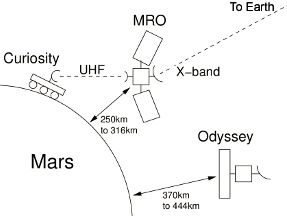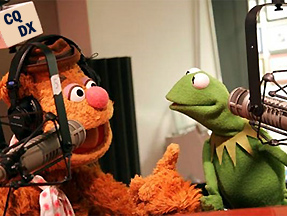Thursday 22 January, 2015, 10:48 - Amateur Radio, Broadcasting, Licensed, Radio Randomness, Spectrum Management
Radio amateurs with designs on operating from the planet Mars are appealing against a decision by the Consultative Committee for Space Data Systems (CCSDS) to allocate the 70 cm amateur band (430 - 440 MHz +/-) for communications between satellites in orbit around the red planet and the numerous rovers that criss-cross its surface. In a statement, released by the Mars United People for Planetary and Earth Transmissions (MUPPETs), tea-drinking general secretary Arthur Dent said,
MUPPETs have been planning a DX-pedition to Mars for some time. To discover that our officially allocated radio frequencies are already in use is just not fair. It constrains our ability to talk about radio stuff to each other and means other radio amateurs around the solar-system will be denied extra points in the forthcoming 'talking about radio stuff with other radio nuts' contest.
Responding to the accusations, Prostetnic Vogon Jeltz of the CCSDS commented,
The 70cm frequency band has been used for communications on and off Mars since the Viking lander first set foot on the planet back in 1976. The MUPPETs have had plenty of time to comment. The plans for frequency use on Mars have been available at the local planning office on Alpha Century for fifty of your Earth years, so they've had plenty of time to lodge any formal complaints and it's far too late to start making a fuss about it now. I'm sorry but if they can't be bothered to take an interest in local affairs that's their own regard.
Appallingly obvious references to the Hitch-Hikers Guide to the Galaxy aside, it may surprise many people to learn that there is, indeed, a frequency plan for Mars. And that there are already 5 communication satellites in orbit around the planet! For communication from the rovers on the surface to the orbiting satellites, frequencies in the range 390 to 405 MHz are used. For the link down from the orbiters to the rovers, the frequency range 435 - 450 MHz is used, which falls inside the amateur radio 70cm band.
The choice of the particular frequencies in use (on Mars) is designed to try and stop anyone deliberately causing interference from the Earth, whilst retaining ease of use on Mars (i.e. the ability to use omni-directional antennas). The various satellites orbiting Mars typically get no nearer than around 400 km from the surface and communication with rovers typically takes place when the satellites make their closest pass. The shortest distance between the Earth and Mars is typically around 60 million km. The table below shows the path-loss at 415 MHz of these distances.
| Route | Distance | Path Loss |
|---|---|---|
| Satellite to Mars surface | 400 km | 137 dB |
| Earth to Mars | 60,000,000 km | 240 dB |
So the difference in path loss is just over 100 dB. For a transmitter to cause interference from the Earth to communication on Mars, it would therefore have to have a radiated transmitter power 100 dB higher than the signals passing between the rovers and the satellites.
 A very good description of the communications with Mars is provided by Steven Gordon (from whom the diagram on the left is shamelessly plagiarised). The transmitter power used on Mars is 5 Watts (7 dBW), so in order to cause interference from Earth, a transmitter power of around 107 dBW, or 50,000,000,000 Watts (a.k.a. 50 GigaWatts) would be required. Would it be possible to generate such a signal?
A very good description of the communications with Mars is provided by Steven Gordon (from whom the diagram on the left is shamelessly plagiarised). The transmitter power used on Mars is 5 Watts (7 dBW), so in order to cause interference from Earth, a transmitter power of around 107 dBW, or 50,000,000,000 Watts (a.k.a. 50 GigaWatts) would be required. Would it be possible to generate such a signal?Firstly, it ought to be possible to generate at least 100,000 Watts (100 kiloWatts or 50 dBW) of power at the necessary frequencies as television transmitters for the UHF band that reach this level are available. So what is then required is an antenna with a gain of 57 dB. This requires a dish with a diameter of around 150 metres. The largest dish antenna in the world is the radio telescope at Arecibo, Puerto Rico, which is 305 metres in diameter.
 If a high powered television transmitter was therefore connected up to the Arecibo radio telescope antenna, it ought to be more than possible to jam the transmissions between the Mars rovers and the orbiting satellites during periods where the Earth and Mars were closely aligned. Of course this kind of power level is way beyond the normal licensing conditions of a typical radio amateur and the right conditions would occur roughly every 2 to 3 years when the Earth and Mars come closer together. Nonetheless, commenting on this finding, Arthur Dent of the MUPPETs jeered,
If a high powered television transmitter was therefore connected up to the Arecibo radio telescope antenna, it ought to be more than possible to jam the transmissions between the Mars rovers and the orbiting satellites during periods where the Earth and Mars were closely aligned. Of course this kind of power level is way beyond the normal licensing conditions of a typical radio amateur and the right conditions would occur roughly every 2 to 3 years when the Earth and Mars come closer together. Nonetheless, commenting on this finding, Arthur Dent of the MUPPETs jeered,Safe from interference, eh? Who looks silly now then Jeltz!
